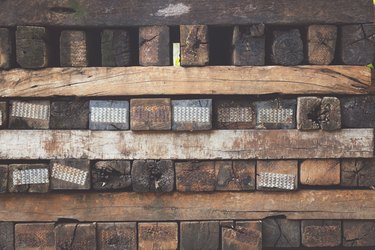
If you're wondering how to grade railroad ties, it's important to understand the relationship between grading and quality. Grading refers to the size and type of railroad tie, as well as the number of defects present.
However, it is also important to understand the effects of railroad ties on the environment. You should never use railroad ties on a residential property, although they may be sold for other purposes. The standard dimensions for the ties are 8 feet, 6 inches long by 9 inches wide by 7 inches thick. If you had been hoping to use railroad ties at home for a project, you should purchase new timber or lumber instead. This can give a similar aesthetic without the harmful effects of using railroad ties.
Video of the Day
Video of the Day
Are Railroad Ties Safe?
Railroad ties could seem like a nice touch to a residential property. However, they should never be used in your yard or around your home.
Many lumber yards sell used railroad ties, and they have often been treated with creosote. This oily substance is a pesticide that also acts as a wood preservative. The Environmental Protection Agency (EPA) has not approved the use of creosote-treated railroad ties for residential use. Although more studies need to be completed, creosote has been linked to skin irritation, respiratory problems, risk for cancer and other medical problems.
The EPA discourages the use of creosote in landscaping and especially anywhere close to gardens. Creosote can also contaminate water and soil and can be toxic to wildlife. There are untreated woods that can be used as alternatives for railroad ties. Some choices include cedar, black locust, cypress and redwood. EPA-approved pressure-treated wood also is suitable for outdoor projects (especially where there is ground contact), but treated materials are not recommended near vegetable gardens or other areas where edible plants are grown.
Grades of Railroad Ties
The highest grade of railroad ties is called "relay" or "premium." Material in this grade may look brand new or be made of solid, straight wood with very few cracks. You will notice their dark color, which is a sign of creosote treatment.
"Landscape grade," or No. 1, railroad ties are the next level down, and they are the most common type. These are also made from durable, solid wood and have either three or four straight sides. There may be some wear and splitting on the ends but not much. Grade No. 1 railroad ties will also have a dark color from creosote treatment.
Next, No. 2 railroad ties will likely have excessive wear plus larger splits on the ends. They will have two or three straight sides, and you may also see missing edges, plate cutting (this is internal damage to the tie caused by movement of the tie plate over time) and minimal dry rot. They are not of the same quality as the higher grades.
Lower-Quality Railroad Ties
No. 3 grade railroad ties also exist, but these only have one or two solid sides remaining; they may also be called scrap or economy ties. The wood might be strong, but the ties will probably have even larger splits on their ends and more plate cuts. This type of railroad tie is often ground up into mulch or sold in other ways.
Used railroad ties may or may not have railroad tie plates attached. These thick steel panels attach the ties to the tracks. In general, the lower the grade of the railroad tie, the more scratched and deteriorated the plate will be.
- Capitol City Lumber Co.: Used #1 Railroad Ties
- United States Environmental Protection Agency: Creosote
- AGICO Group: What Are Railroad Tie Plates Made Of?
- Track Builders: Relay Ties for Sale
- Home Depot: Unbranded #2 Railroad Ties
- Putnam Lumber & Export Co.: Used Rail Road Ties
- Railroad Tie Association: Comparison of Specifications for Grade and Industrial Grade (IG) Crossties
- A&K Railroad Materials, Inc.: FAQ